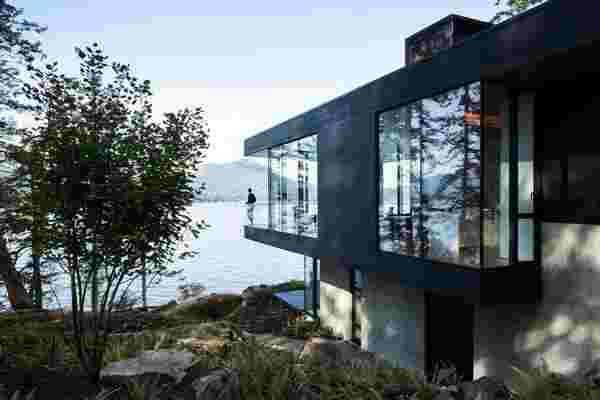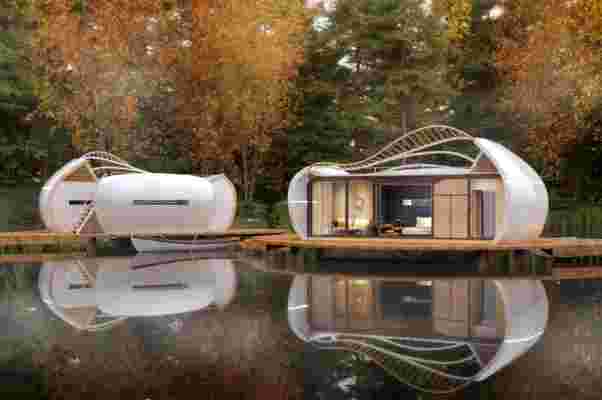
Designed so that you can have a cabin in the woods, a house on the lake, or a property on the beach whenever you want, the Time Holiday is a mobile home that’s focused on what designer Chester Goh calls ‘futuristic sustainability … or basically architecture that’s nomadic , so you don’t need to build multiple homes.
While the term ‘futuristic sustainability’ definitely sounds like jargon, the idea of a mobile home really makes sense from an ecological and economical standpoint. The mobile home belongs solely to you and isn’t bound by a location. It gives you the freedom to constantly relocate, finding a suitable spot to park yourself and live in, so you’re not stuck in expensive cities, compartmentalized in tiny overpriced rental apartments, or heavily affected by natural calamities affecting your neighborhood.
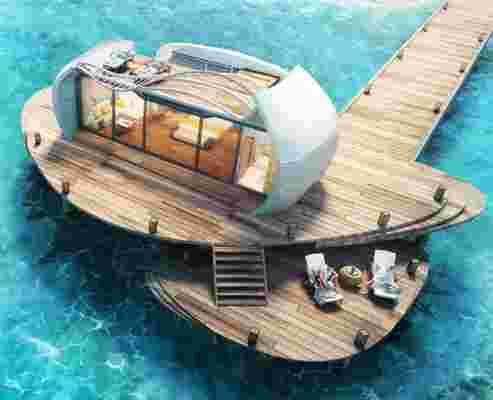
Saving on total costs and unnecessary construction waste, these modular pods/villas come prefabricated and do not require any foundation. They’re built to be stable, spacious, and structurally sound, and can easily be lifted up and shifted anywhere on the planet without any limitations to terrains and topography. “Wanting to wake up to the morning of serene blue sea, lush green grassland, or a majestic golden dessert in a modular pod that is closely connected to nature has been the driving inspiration to this project”, says designer Chester Goh
The outer structure is fabricated from a single curved sheet of fiberglass, designed to withstand various topographies and climates. The front and side, however, constitute full-frame floor-to-ceiling double-layer laminated glass panels that provide extravagant 360-degree unobstructed views of the outdoors, while helping insulate the interiors. The entire structure is designed to telescopically expand/contract, allowing the house to assume a compact form in transit, and extend outwards to create larger spaces and an extra guest room. There’s even access to a terrace on the top, because what’s the point of shifting your home to a scenic spot if you can’t really absorb the area’s beauty from the roof of your mobile home? Glass of sangria not included!
The Time Holiday Mobile Home is a Gold Winner of the A’ Design Award for the year 2021.
Designer: Chester Goh
This cabin is elevated by a single pillar above Finland’s dense forest for an immersive winter getaway!
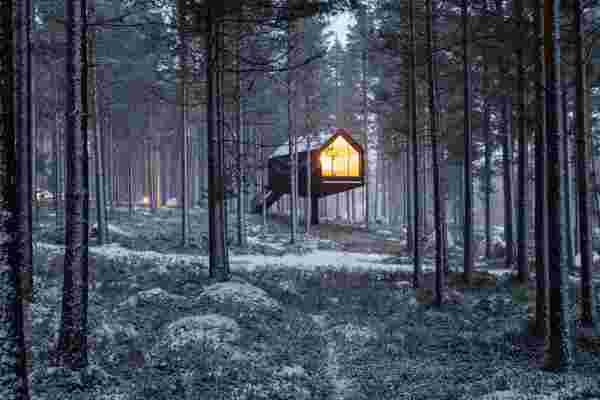
Dedicated to providing eco-friendly micro-hospitality solutions in far-reaching destinations, Studio Puisto is at it again. Following the success of their tiny, modular cabin design , ‘Space of Mind’ , Studio Puisto, a sustainable interior design studio based in Finland, recently debuted the first prototype of cabins soon to be part of a larger hospitality project called Kivijärvi Resort. Once completed, the resort, situated near Salamajärvi National Park, will comprise of 25 cabins that vary in both design and structure to adhere to the ever-changing landscape of Finland’s dense, snow-covered forest, offering accommodations for guests looking for an elevated, yet immersive getaway in nature.
The resort’s first completed cabin is called Niliaitta, which refers to the traditional storage structure built at the end of a high pillar, used by the Sámi people to store food and equipment, keeping it safe from the grasp of hungry or curious wildlife. In order to immerse guests of Kivijärvi Resort in the elements of nature as safely, but also as close as possible, Studio Puisto installed a floor-to-ceiling window that stands some distance from the cabin’s deep gable roof. From Niliaitta’s front-facing window, guests enjoy the most dominant landscapes as the cabin’s location was purposefully selected to offer the most unobstructed views of Finland’s forest and nearby body of water. The cabin itself is painted twilight black to disappear into the darkness come night, but the warm, wooden panels that line Niliaitta’s interiors provide a cozy refuge that glows with relaxed, ambient lighting.
Maintaining the forest’s original terrain was a top priority for the architects at Studio Puisto, which meant that Niliaitta’s location was strategically decided upon based on whichever location required the least number of trees to be cut down. Since the whole structure rests only on a single pillar, there was only minimal contact with the natural environment and landscape during construction – the final structure requiring the removal of only a few trees. When sourcing their material for construction, Studio Puisto avoided plastic, opting instead for wood to build the cabin’s frame, walls, roof, and base. In a similar pursuit of sustainability, Niliaitta was insulated using eco-wool, a natural type of thermal insulation that traps air in millions of tiny air pockets found in the insulator’s fibers.
With both hospitality and sustainability at the forefront of these designers’ plans for Kivijärvi Resort, Niliaitta currently offers all the luxuries found in high-end hotel experiences including, a ventilation unit, air-source heat pump, water heater, and electrical switchboard. Then, a bathroom, spacious shower, as well as a kitchenette can all be found in the rotating core in the middle of the cabin in addition to the more mechanical luxuries mentioned above. Water, sewer, and electrical lines run to Niliaitta under the cabin’s external staircase. Offering guests with these conveniences of daily life was just as important to Studio Puisto as was the cabin’s elevated immersive nature, “The idea is that by simply retreating away up in the air, we feel immediately detached from our everyday worries happening on the ground.”
Designer: Studio Puisto
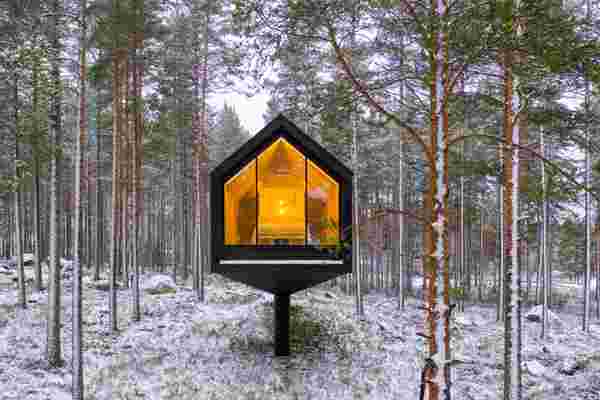
This contemporary cabin was made using sustainable construction materials like cedar and glass!
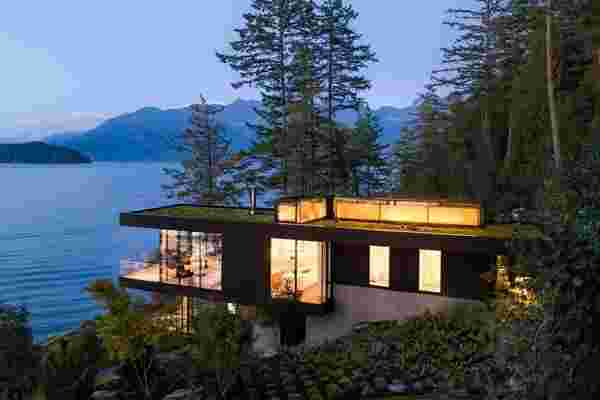
Raise your hand if you want a cabin nestled on the shores of a stunning island away from all the unprecedented times? I found this contemporary cabin that gets extra points because it is constructed from sustainable building materials like cedar and glass. Named after the island itself, the Bowen Island House forges deep connections with the environment while minimizing environmental impact with its design that touches lightly on the ground.
Set on a rugged, 8-acre site on the secluded side of the island, the cabin offers magical views of the lush, lichen-covered rainforest and the serene bay water that surrounds it. The island is secluded from the dense population of Canadian cities but recent developments on and around it have left the natural sanctuary vulnerable. The Office of McFarlane Biggar Architects + Designers (OMB) have created an environmentally friendly alternative with a small environmental footprint to encourage sustainable travel and construction. “The views and access to sunshine were really the key considerations that helped us position the home,” says the architect. The cabin’s position is perpendicular to the rocky coastline and captures the sun from east to west, while the stained black cedar cladding helps it visually recede into the forest. The cast-in-place concrete walls connect the constructed elements to the natural elements as well as large areas of outdoor decks that look out over the water.
The lower floor has exposed concrete while the upper level features blackened cedar cladding. You enter the cabin from the rear elevation on the second floor. The glazed door provides a mesmerizing view straight through the length of the house and out to the water – if you have a dog, I imagine they will dash straight through this and I don’t blame them! The passage then leads down into the main social area of the structure which extends out onto a covered deck that immerses you right between the trees and the water. The master bedroom is directly below the living area on the second floor and mirrors the space above with regards to the breathtaking views. The interiors are minimal, airy, and designed to allow for maximum natural light and ventilation – it creates a feeling of warmth and openness. The contrast between the white walls, the wooden floors, and the high ceilings will draw your eye forward and highlight the reason you are probably there – the scenic setting.
The minimal, two-level cabin is clad in locally sourced cedar and insulated glass. It has an area of 2930 ft2 (272.2 m2) that holds three bedrooms, two bathrooms, an open-plan kitchen, a dining room, and a living area. Designed to be off-the-grid it includes functionalities and independent sources for heat and electricity that help minimize the home’s footprint. The team also prioritized simple details in its design to ensure minimal disruption to the natural surroundings during construction. “We were interested in this idea of treading lightly on the site. Using a green roof is a logical extension of that. When you introduce a building that supplants a little bit of the forest floor, it’s nice to replicate that on the roof as a return gesture to continue to create habitat for birds, animals, and plants, and to help manage the flow of stormwater,” explains McFarlane. Bowen Island House’s panoramic glass windows, modern aesthetics, mindful construction, and sweeping views make it one of the most stunning cabin designs I have seen.
Designer: Office of McFarlane Biggar Architects + Designers (OMB)
